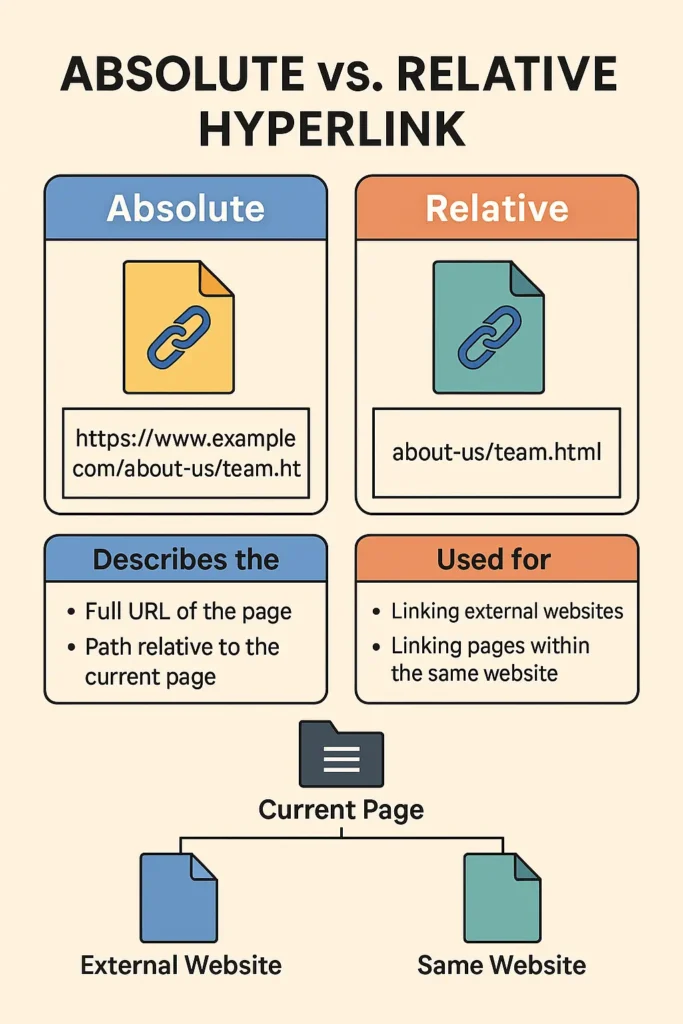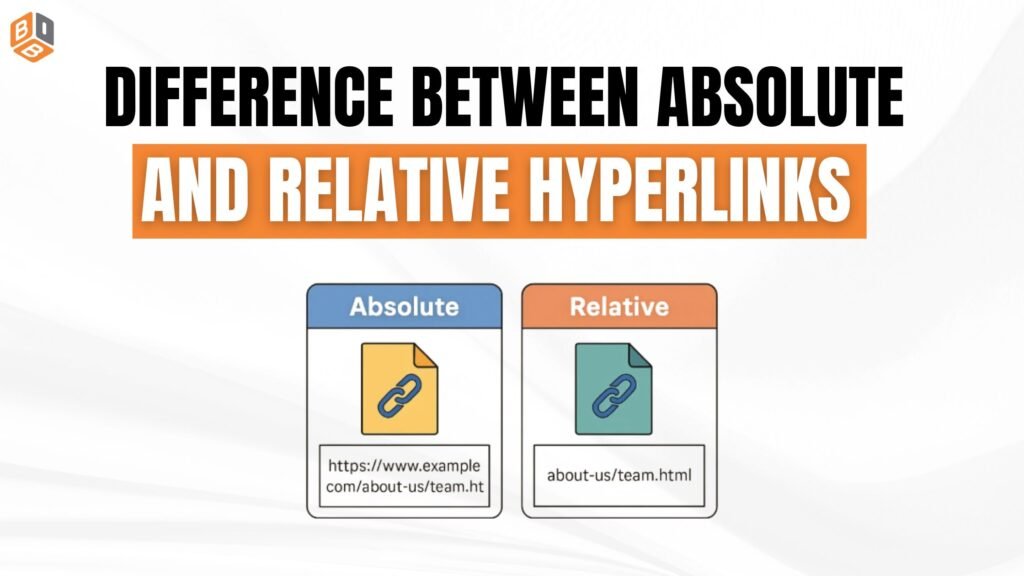In the realm of web development and digital content creation, hyperlinks are considered the very backbone of the World Wide Web: they allow web users to travel across the web in search of information and resources. The two major kinds of hyperlinks – absolute and relative hyperlinks – are used for linking and accessing content on the web and thereby have a flavor of distinction.
Knowing this difference is important to web developers and content managers to be sure of proper and efficient navigation, SEO optimization, and site management.
What is a Hyperlink?
A hyperlink (or simply “link”) is a point or to an element in a webpage from one location to another, either inside the same site or to an entirely different site. They can be text, an image, a button, or any clickable element using an <a> HTML tag that directs you towards another document or place.
<a href=”https://example.com”>Visit Example</a>
With that said, let us understand absolute and relative links.
What is an Absolute Hyperlink?
An absolute link specifies the full URL of a document or resource. It contains the protocol, like HTTP or HTTPS, the domain name, and the whole directory structure up to the file.
Example:
<a href=”https://www.example.com/about-us/team.html”>Our Team</a>
Here, clicking on the link will take you to the exact URL under the example.com domain, regardless of where the HTML file containing this link is placed.
Pros of Absolute Links:
| Advantage | Explanation |
| Universally Recognizable | Always points to the exact location, regardless of where the current page resides. |
| Good for External Links | Perfect when linking to external sites. |
| Fewer Errors | Less prone to errors from structural changes. |
Cons of Absolute Links:
- Longer to type or copy.
- Can break if domain or site structure changes.
What is a Relative Hyperlink?
Relative links link a resource by giving it a path relative to the current document’s location. So, no domain or full path is used.
Example:
<a href=”about-us/team.html”>Our Team</a>
This link assumes the about-us/team.html file is in the same directory structure relative to the current page.
Pros of Relative Links:
| Advantage | Explanation |
| Shorter and Cleaner | Easier to manage within internal documents. |
| Flexible for Development | Works well in development environments and templates. |
| Easier to Move | If you move the website to a new domain, links still work. |
Cons of Relative Links:
- Can break if the directory structure changes.
- Not suitable for external resources.
Illustrative Example For the Difference Between Absolute and Relative Hyperlinks: Folder Structure
Here’s a simple visual representation to clarify when to use absolute vs. relative links:
Folder Structure:
/website
index.html
/about
team.html
/images
logo.png

Example 1: Relative Link from index.html to team.html
<a href=”about/team.html”>Our Team</a>
Example 2: Absolute Link to an external image
<img src=”https://cdn.example.com/images/logo.png” alt=”Logo”>
When to Use Which?
| Use Case | Recommended Link Type |
| Linking to a page on your site from another page | Relative |
| Linking to an external website | Absolute |
| Website development with local preview | Relative |
| Linking from an email or ad campaign | Absolute |
Real-World Application in Web Projects
Imagine that your website consists of 50 internal pages. Absolute links will then require you to manually update every link if your site gets relocated from www.dev-example.com to www.example.com.
With relative links, you won’t need to change anything — your internal links will work as long as your folder structure stays the same.
SEO Implications
From an SEO standpoint:
- Absolute URLs help search engines identify and index content more consistently.
- Relative URLs can create duplicate content issues if your site has both www and non-www or http and https versions.
- Best practice: Absolute links should be used for canonical pages and external resources; relative links should be used for internal navigation.
Best Practices
- Be Consistent: Pick one style and apply it where appropriate.
- Use HTTPS in Absolute URLs: An absolute link is a secure link.
- Test Your Links: Especially after moving folders or changing a domain.
- SEO Audit Tools: Use tools like Screaming Frog or Ahrefs to identify broken or inferior links.
Conclusion
The academic understanding of the theoretical distinction between absolute and relative hyperlinks seems to have practical web considerations: design, development, SEO, and site maintenance. Absolute links provide precision and reliability, especially for external destinations; relative links offer flexibility and efficiency within internal site architecture.
When you combine the two links in a proper way, your website will be easier to maintain, more SEO-friendly, and less prone to changes in its structure.














